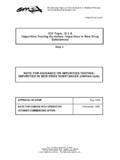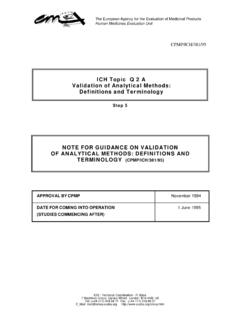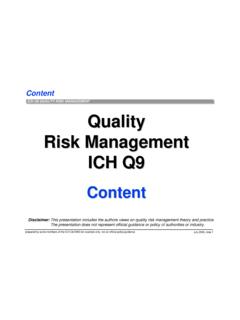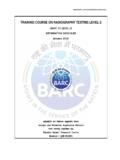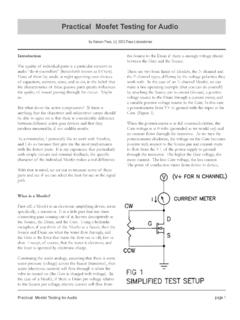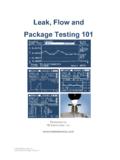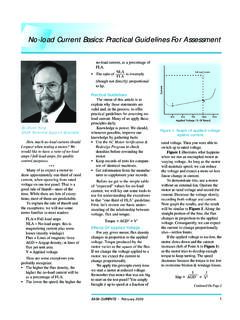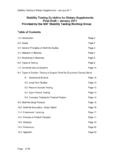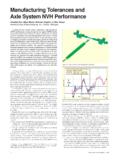Transcription of ICH Topic Q 1 A Stability Testing Guidelines: Stability ...
1 The European Agency for the Evaluation of Medicinal Products Human Medicines Evaluation Unit CPMP/ICH/380/95. ICH Topic Q 1 A. Stability Testing Guidelines: Stability Testing of New Drug Substances and Products Step 5. NOTE FOR GUIDANCE ON Stability Testing : Stability . Testing OF NEW DRUG SUBSTANCES AND PRODUCTS. (CPMP/ICH/380/95). [This guideline replaces relevant section of previous guideline]. APPROVAL BY CPMP December 1993. STUDIES CAN BE SUBMITTED ACCORDING TO THIS GUIDELINE January 1994. DATE FOR COMING INTO OPERATION 1 January 1998. (DOSSIERS SUBMITTED AFTER). ICH - Technical Coordination - R. Bass 7 Westferry Circus, Canary Wharf, London E14 4HB, UK. Tel: (+44-171) 418 84 11 Fax: (+44-171) 418 85 51. E_Mail: Stability Testing OF NEW DRUG SUBSTANCES. AND PRODUCTS. ICH Harmonised Tripartite Guideline [EMEA Status as of December 1993]. Preamble The following guideline sets out the Stability Testing requirement for a Registration Application within the three areas of the EC, Japan and the USA.
2 It does not seek necessarily to cover the Testing that may be required for registration in or export to other areas of the world. The guideline seeks to exemplify the core Stability data package required for new drug substances and products. It is not always necessary to follow this when there are scientifically justifiable reasons for using alternative approaches. The guideline provides a general indication on the requirements for Stability Testing , but leaves sufficient flexibility to encompass the variety of different practical situations required for specific scientific situations and characteristics of the materials being evaluated. The principle that information on Stability generated in any one of the three areas of the EC, Japan and the USA would be mutually acceptable in both of the other two areas has been established, provided it meets the appropriate requirements of this guideline and the labelling is in accord with national/regional requirements. Details of the specific requirements for sampling, test requirements for particular dosage forms/packaging etc.
3 , are not covered in this guideline. Objective The purpose of Stability Testing is to provide evidence on how the quality of a drug substance or drug product varies with time under the influence of a variety of environmental factors such as temperature, humidity and light, and enables recommended storage conditions, re-test periods and shelf lives to be established. Scope The guideline primarily addresses the information required in Registration Applications for new molecular entities and associated drug products. This guideline does not currently seek to cover the information required for abbreviated or abridged applications, variations, clinical trial applications, etc. The choice of test conditions defined in this guideline is based on an analysis of the effects of climatic conditions in the three areas of the EC, Japan and the USA. The mean kinetic temperature in any region of the world can be derived from climatic data (Grimm, W. Drugs Made in Germany, 28, 196-202, 1985 and 29, 39-47, 1986).
4 CPMP/ICH/380/95 1/13. DRUG SUBSTANCE. General Information on the Stability of the drug substance is an integral part of the systematic approach to Stability evaluation. Stress Testing Stress Testing helps to determine the intrinsic Stability of the molecule by establishing degradation pathways in order to identify the likely degradation products and to validate the Stability indicating power of the analytical procedures used. Formal Studies Primary Stability studies are intended to show that the drug substance will remain within specification during the re-test period if stored under recommended storage conditions. Selection of Batches Stability information from accelerated and long term Testing is to be provided on at least three batches. The long term Testing should cover a minimum of 12 months duration on at least three batches at the time of submission. The batches manufactured to a minimum of pilot plant scale should be by the same synthetic route and use a method of manufacture and procedure that simulates the final process to be used on a manufacturing scale.
5 The overall quality of the batches of drug substance placed on Stability should be representative of both the quality of the material used in pre-clinical and clinical studies and the quality of material to be made on a manufacturing scale. Supporting information may be provided using Stability data on batches of drug substance made on a laboratory scale. The first three production batches of drug substance manufactured post approval, if not submitted in the original Registration Application, should be placed on long term Stability studies using the same Stability protocol as in the approved drug application. Test Procedures and Test Criteria The Testing should cover those features susceptible to change during storage and likely to influence quality, safety and/or efficacy. Stability information should cover as necessary the physical, chemical and microbiological test characteristics. Validated Stability -indicating Testing methods must be applied. The need for the extent of replication will depend on the results of validation studies.
6 Specification Limits of acceptability should be derived from the profile of the material as used in the pre- clinical and clinical batches. It will need to include individual and total upper limits for impurities and degradation products, the justification for which should be influenced by the levels observed in material used in pre-clinical studies and clinical trials. CPMP/ICH/380/95 2/13. Storage Conditions The length of the studies and the storage conditions should be sufficient to cover storage, shipment and subsequent use. Application of the same storage conditions as applied to the drug product will facilitate comparative review and assessment. Other storage conditions are allowable if justified. In particular, temperature sensitive drug substances should be stored under an alternative, lower temperature condition which will then become the designated long term Testing storage temperature. The six months accelerated Testing should then be carried out at a temperature at least 15 C above this designated long term storage temperature (together with the appropriate relative humidity conditions for that temperature).
7 The designated long term Testing conditions will be reflected in the labelling and re-test date. Conditions Minimum Time Period at Submission Long term Testing 25 C 2 C/ 60% RH 5% 12 Months Accelerated Testing 40 C 2 C/75% RH 5% 6 Months Where 'significant change' occurs during six months storage under conditions of accelerated Testing at 40 C 2 C/75 percent RH 5 percent, additional Testing at an intermediate condition (such as 30 C 2 C/60 percent RH 5 percent) should be conducted for drug substances to be used in the manufacture of dosage forms tested long term at 25 C/60 percent RH and this information included in the Registration Application. The initial Registration Application should include a minimum of 6 months data from a 12 months study. 'Significant change' at 40 C/75 percent RH or 30 C/60 percent RH is defined as failure to meet the specification. The long term Testing will be continued for a sufficient period of time beyond 12 months to cover all appropriate re-test periods, and the further accumulated data can be submitted to the Authorities during the assessment period of the Registration Application.
8 The data (from accelerated Testing or from Testing at an intermediate condition) may be used to evaluate the impact of short term excursions outside the label storage conditions such as might occur during shipping. Testing Frequency Frequency of Testing should be sufficient to establish the Stability characteristics of the drug substance. Testing under the defined long term conditions will normally be every three months, over the first year, every six months over the second year and then annually. Packaging/Containers The containers to be used in the long term, real time Stability evaluation should be the same as or simulate the actual packaging used for storage and distribution. CPMP/ICH/380/95 3/13. Evaluation The design of the Stability study is to establish, based on Testing a minimum of three batches of the drug substance and evaluating the Stability information (covering as necessary the physical, chemical and microbiological test characteristics), a retest period applicable to all future batches of the bulk drug substance manufactured under similar circumstances.
9 The degree of variability of individual batches affects the confidence that a future production batch will remain within specification until the retest date. An acceptable approach for quantitative characteristics that are expected to decrease with time is to determine the time at which the 95% one-sided confidence limit for the mean degradation curve intersects the acceptable lower specification limit. If analysis shows that the batch to batch variability is small, it is advantageous to combine the data into one overall estimate and this can be done by first applying appropriate statistical tests (for example, p values for level of significance of rejection of more than ) to the slopes of the regression lines and zero time intercepts for the individual batches. If it is inappropriate to combine data from several batches, the overall retest period may depend on the minimum time a batch may be expected to remain within acceptable and justified limits. The nature of any degradation relationship will determine the need for transformation of the data for linear regression analysis.
10 Usually the relationship can be represented by a linear, quadratic or cubic function on an arithmetic or logarithmic scale. Statistical methods should be employed to test the goodness of fit of the data on all batches and combined batches (where appropriate) to the assumed degradation line or curve. The data may show so little degradation and so little variability that it is apparent from looking at the data that the requested retest period will be granted. Under the circumstances, it is normally unnecessary to go through the formal statistical analysis but merely to provide a full justification for the omission. Limited extrapolation of the real time data beyond the observed range to extend expiration dating at approval time, particularly where the accelerated data supports this, may be undertaken. However, this assumes that the same degradation relationship will continue to apply beyond the observed data and hence the use of extrapolation must be justified in each application in terms of what is known about the mechanism of degradation, the goodness of fit of any mathematical model, batch size, existence of supportive data etc.
